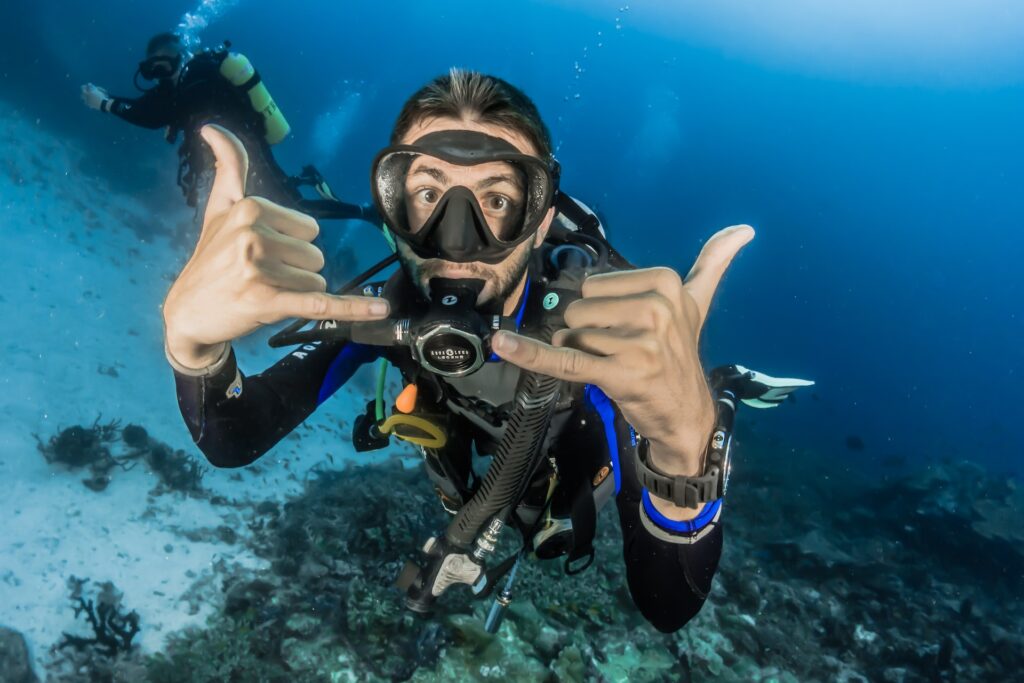What To Wear For Scuba Diving?: The Ultimate Guide to Dive Gear
Are you preparing for an exciting scuba diving adventure? Exploring the fascinating underwater world through scuba diving can be an exhilarating and unforgettable experience. However, before you dive deep into the depths, it’s essential to ensure you have the correct gear to make your adventure safe, comfortable, and enjoyable, it’s crucial to equip yourself with the right gear to ensure a safe and comfortable experience.
In this comprehensive guide, I will discuss what to wear for scuba diving and take you through the essential clothing and equipment needed for scuba diving. From wetsuits to masks, fins, and more, I’ve got you covered. So, let’s dive right in!
Getting the Right Wetsuit

Wetsuits play a vital role in keeping you warm throughout your dive and protecting your body from any potential scrapes or stings. Here are some key points to consider:
Full-Length or Shorty?
Depending on the water temperature and your personal preference, you can choose between a full-length or shorty wetsuit. Full-length wetsuits cover your entire body and are perfect for cooler waters, while shorties provide more freedom of movement and are suitable for warmer climates.
Material Matters
Neoprene, a synthetic rubber, is the most common material used in wetsuits. Opt for a wetsuit with a thickness that matches the water temperature and diving environment. Thicker wetsuits provide better insulation in colder waters.
Snug Fit is an Essential
Ensure your wetsuit fits snugly but doesn’t restrict your movement. A wetsuit that is too loose will allow water to flush in, reducing its insulation properties.
Masks and Snorkels: Clear Vision Below the Surface

A properly fitting mask is crucial for an enjoyable scuba diving experience. Follow these tips to choose the right one:
Finding the Perfect Fit
Try on different masks to find the one that fits your face comfortably and creates a watertight seal. Make sure it covers your nose completely and doesn’t press against your forehead or cheekbones.
Clear Lenses for Better Visibility
Opt for masks with tempered glass lenses for superior clarity and durability. Additionally, consider choosing masks with anti-fog features to prevent condensation during your dive.
Snorkels for Surface Breathing
While not necessary for all dives, a snorkel can be a handy addition for surface breathing and conserving air in between dives. Look for a snorkel with a comfortable mouthpiece and a purge valve to clear any water that may enter.
Fin Selection: Glide Through the Water

Selecting the right pair of fins can significantly impact your underwater propulsion and maneuverability. Consider the following factors:
Full Foot or Open Heel
Full-foot fins are ideal for warm-water diving and snorkeling, as they provide a snug fit similar to socks. Open-heel fins, on the other hand, are suited for colder waters and offer adjustable straps that accommodate booties.
Blade Style and Length
Longer blades on fins provide more thrust, ideal for strong kicks and currents. Conversely, shorter blades are suitable for divers who prefer a more relaxed pace. Choose a blade style and length that aligns with your diving style and comfort.
Booties for Comfort and Protection
If you opt for open-heel fins, wearing booties is vital for added comfort, insulation, and protection against potential hazards like sharp rocks or coral.
Additional Gear: Enhancing Your Dive Experience

While wetsuits, masks, and fins are the essentials, there are a few more pieces of gear worth considering to enhance your scuba diving adventure:
Dive Gloves: Protecting Your Hands
Dive gloves provide thermal protection and shield your hands from abrasions, stings, and scratches. Choose gloves with appropriate thickness and materials depending on the water temperature.
Hoods: Heat Retention
In colder waters, a hood is crucial to prevent heat loss through your head. Look for hoods with a snug fit around your neck and diversify materials to provide insulation.
Dive Watches: Timing Your Dive
Investing in a dive watch can help you keep track of your time underwater, monitor decompression stops, and stay within safe limits. Look for watches with reliable water-resistance ratings, visibility in low-light conditions, and a robust strap.
Understanding The Buoyancy Control Device (BCD)

A BCD, or buoyancy control device, is a crucial piece of gear that allows you to control your buoyancy underwater. It also serves as a storage device for your scuba tank. Here’s what you need to know:
Features to Consider
- Ensure the BCD has adjustable straps to achieve a comfortable fit.
- Look for integrated weight pockets rather than using a weight belt for added convenience.
- Opt for a BCD with sufficient lift capacity to support your body weight and any additional equipment you may carry.
Inflation and Deflation
- BCDs have an inflation system that allows you to add air to increase buoyancy. This can be done using either an alternate air source or an oral inflator.
- The deflation system enables you to release air to decrease buoyancy, providing better control during ascents and descents.
Mastering the use of your BCD will give you the ability to maintain neutral buoyancy and effortless movement throughout your dive.
Common Mistakes to Avoid in Scuba Diving
Scuba diving is a mesmerizing pursuit that opens up a world of underwater wonders. However, amidst the allure of the ocean’s depths, it’s crucial to navigate with caution. Let’s unravel the common mistakes that divers often make, jeopardizing safety and the overall diving experience.
Neglecting Equipment Inspection
The Foundation of Safety
Ensuring your scuba diving equipment is in impeccable condition is non-negotiable. A mistake as simple as neglecting equipment inspection can have dire consequences underwater. Before each dive:
- Regulator Functionality: Test the regulator for smooth airflow, ensuring there are no unusual sounds.
- Secure Tank Connection: Verify the secure attachment of the tank to prevent potential leaks during the dive.
- Wetsuit Condition: Thoroughly inspect your wetsuit for any tears, holes, or worn-out areas that could compromise its effectiveness.
Ignoring Dive Planning
The Blueprint for Safety
In the excitement of a dive, some divers overlook the importance of meticulous dive planning. This error can lead to a cascade of issues:
- Dive Duration: Stick to predetermined bottom times to avoid the risk of decompression sickness. Ignoring these guidelines can have serious health implications.
- Depth Limits: Respect the depth limits recommended for each dive. Exceeding these limits increases the risk of nitrogen-related complications.
- Emergency Procedures: Familiarize yourself with emergency ascent procedures and safety stops. Preparedness is the key to averting crises underwater.
Poor Buoyancy Control
Balancing Act
Buoyancy control is an art that every diver must master. Poor control can lead to exhaustion, increased air consumption, and uncontrolled ascents:
- Overweighting: Carrying excess weight can strain energy levels and result in increased air consumption. It can also hinder overall mobility.
- Underweighting: Having insufficient weight can lead to uncontrolled ascents, posing a serious risk to the diver and the dive group.
Ignorance of Underwater Signaling

Communicate Without Words
Effective communication underwater is paramount for a safe and enjoyable dive. Ignorance of underwater signaling can lead to confusion and potential hazards:
- Hand Signals: Familiarize yourself with essential hand signals for clear communication with your dive buddy.
- Dive Light Etiquette: Understand and employ dive lights for signaling in low visibility conditions. Proper usage can prevent misunderstandings and keep the dive group cohesive.
Skipping the Safety Stop
A Pivotal Pause
The safety stop is not a mere formality but a crucial aspect of every dive. Skipping this step can result in an increased risk of decompression sickness:
- Three to Five Minutes: Allocate the recommended duration for the safety stop. This allows for the release of excess nitrogen from your body.
- Depth Consideration: Conduct the safety stop at the prescribed depth, adhering to guidelines to ensure its effectiveness.
Conclusion
As I conclude the article, I hope you understood what to wear for scuba diving. As you embark on your scuba diving journey, it’s essential to choose your gear wisely. From wetsuits to masks, fins, and additional accessories, each piece plays a crucial role in your comfort and safety underwater. Preparing for a scuba diving adventure means not only immersing yourself in the breathtaking underwater world but also ensuring your safety and comfort.
By dressing appropriately in the right scuba diving gear, you can maximize your enjoyment and reduce the risks associated with underwater exploration. Remember to invest in quality gear, keep your equipment well-maintained, and always adhere to proper safety protocols. Now, get ready to dive into a world of wonder and create unforgettable memories!
Happy Diving…
Remember, selecting the right scuba diving gear is essential to ensure a safe and enjoyable underwater exploration.
Frequently Asked Questions
For more information on traveling and destination recommendations, check out my other articles on WanderingNotLost.org
Wanderingnotlost.org is a participant in the Amazon Services LLC Associates Program, an affiliate advertising program designed to provide a means for website owners to earn advertising fees by advertising and linking to amazon(.com, .co.uk, .ca etc) and any other website that may be affiliated with Amazon Service LLC Associates Program.As an Amazon Associate, I earn from qualifying purchases

